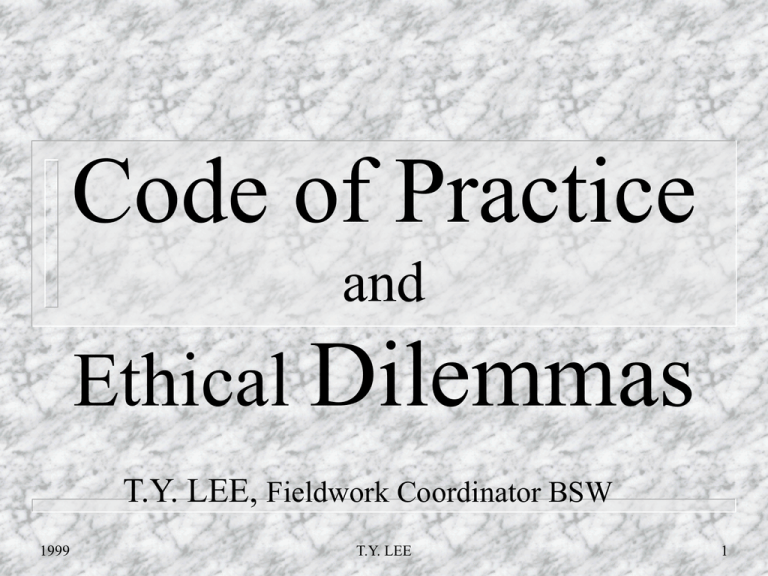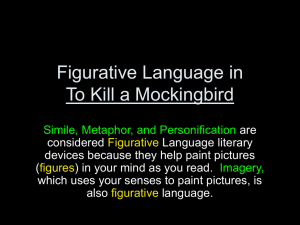Code of Ethics and Ethical Dilemmas
advertisement

Code of Practice and Ethical Dilemmas T.Y. LEE, Fieldwork Coordinator BSW 1999 T.Y. LEE 1 The Code of Practice for Registered Social Workers in Hong Kong Prepared by The Hong Kong Social Workers Registration Board 1999 T.Y. LEE 2 The Code of Practice an operational statement of the central values of the social work profession. Social work students should be is thoroughly familiar with it. Represents standards of ethical behavior for social workers. 1999 T.Y. LEE 3 Contents of the Code of Practice 1. Basic values and beliefs 2. Principles of practice 1999 T.Y. LEE 4 Principles of Practice Personal Conduct Clients Colleagues Agency Profession Society 1999 T.Y. LEE 5 Violation of the Code of Practice lead to failure in fieldwork assessment may if a placement student breaches the Code, evidence for the malpractice is upheld, his/her fieldwork will be given a when failure or zero mark 1999 T.Y. LEE 6 What is an ethical dilemma? It is a Conflict between ... one’s personal and professional values two values/ethical principles two possible actions each with reasons strongly favorable and unfavorable two unsatisfactory alternatives one’s values/principles and one’s perceived role 1999 the need to act and the need to reflect T.Y. LEE 7 Can ethical dilemma be avoided? You can avoid ethical dilemmas! But... You cannot completely avoid ethical dilemmas! 1999 T.Y. LEE 8 You can avoid ethical dilemmas! An Example Your placement is in a school, you should give prior thought to how you would respond when a child reveals abuse or neglect. Find out how your field instructor wants you to handle these situations. What information does the school expect you will share with concerned teachers? The principal? 1999 T.Y. LEE 9 You cannot completely avoid ethical dilemmas! is best to prepare yourself for them It examining your own values from time to time by learning all you can about: how past ethical problems in your placement settings were resolved. and 1999 T.Y. LEE 10 What are the behaviors that will almost always be viewed as unethical? 1999 T.Y. LEE 11 Sexual intimacy with clients 1999 T.Y. LEE 12 Libeling or slandering a client 1999 T.Y. LEE 13 Sharing confidences without compelling professional reasons 1999 T.Y. LEE 14 Assaulting, causing physical injuries, or placing clients in danger 1999 T.Y. LEE 15 Discriminatory practices 1999 T.Y. LEE 16 Withdrawing services precipitously (abandoning a client) 1999 T.Y. LEE 17 Failure to warn and protect the victim of a violent crime 1999 T.Y. LEE 18 Failure to exercise reasonable precautions with a potentially suicidal client 1999 T.Y. LEE 19 Promising “cures” for problems 1999 T.Y. LEE 20 How do I avoid rushing into ethical dilemmas? Develop a working knowledge of the Code of Practice (by necessity they cannot be specific to every possible ethics violation) By anticipating likely trouble spots before they occur. 1999 T.Y. LEE 21 How do I dilemmas? resolve ethical The first step is recognizing the problem and identifying the source of the conflict. You also must keep all parties informed of your legal and ethical obligations. Engage clients or involved parties in dialogue, and brainstorm the “best” course of action. 1999 T.Y. LEE 22 Make sure you are constantly keeping in mind the mission of the profession and observing the client’s right to self- determination. If you are still unclear about what to do, discuss the situation with your field 1999 instructor. Protect the identity of the client if necessary, and present the situation as a “hypothetical” case if you need external help. T.Y. LEE 23 The priority ranking of ethical principles (Lowenberg and Dolgoff ,1992) An approach for ordering social work values that might help you get off the “horns of a dilemma.” Protection of life Equality Autonomy and freedom Least harm Quality of life Privacy and confidentiality Truthfulness and full disclosure 1999 T.Y. LEE 24 How do I know whether I am doing the right thing? It is not always possible to know, but there is a greater chance that we can feel good about the decision we have to make if we go through a deliberate process where we examine our values, seek additional information, and 1999 consult others. T.Y. LEE 25 A Decision-Making Model: 5 Steps (M.V. Joseph, 1983) 1. 1999 definition of the dilemma, T.Y. LEE 26 A Decision-Making Model: 5 Steps (M.V. Joseph, 1983). looking at all the relevant facts and developing valid arguments for various courses of action, 1999 T.Y. LEE 27 A Decision-Making Model: 5 Steps (M.V. Joseph, 1983) 3. consideration of practice wisdom, personal beliefs and values, and how these might influence the final decision, 1999 T.Y. LEE 28 A Decision-Making Model: 5 Steps (M.V. Joseph, 1983) developing options, exploring compromises, evaluating alternatives in an attempt to find a course of action with 4. the least negative effects, and 1999 T.Y. LEE 29 A Decision-Making Model: 5 Steps (M.V. Joseph, 1983) 5. choosing a position that you can defend. 1999 T.Y. LEE 30 The End Read the Code of Practice and keep a copy while you practice 1999 T.Y. LEE 31






